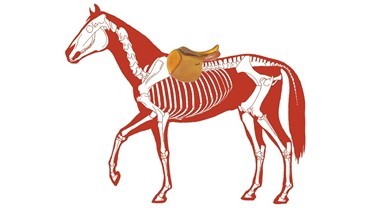The conventional way to measure the length of a saddle is to stretch a tape measure from the centre of the head nail to the centre of the cantle; this gives a measurement in inches.
However, early in the history of BALANCE saddles, we recognised that riders sometimes have a pre-conceived idea of what seat/tree length they should be riding in which proves to be inappropriate to their needs when they try our saddles.
Many people have only ever ridden in saddles that have been made/fitted with a focus on what riders like and without much reference to the needs and the healthy shape of a horse’s body! These saddles tend to be narrow in width.
BALANCE trees and saddles are made and fitted in ways that focus very much on the needs and comfort of the horse, to avoid restriction and damage. This means that they have to be horse shaped and horses are big animals with wide backs (when they are healthy and well enough muscled to carry a rider).
We discovered that when you increase the width of the tree/saddle to give the horse the comfort and room to use its body naturally, it increases the width for the rider as well. For some reason, this makes the seat feel smaller to the rider than an equivalent measurable length in a narrower width. In other words, a 17-inch saddle in a narrow width will feel more generous in the seat than a 17-inch saddle in a wide fit.
When riding in a BALANCE saddle, it's important to keep a good degree of angle (bend) in the hip joint, especially when riding horses that are particularly broad through the ribs and back and need one of the wider BALANCE saddles, otherwise the rider risks strain to the hips and lower back. For this reason, some riders need a slightly more forward-cut flap or slightly longer seat than they might expect, to allow for slightly shorter stirrups than they are used to riding with in a narrower, conventionally fitted saddle.
The letters A-E refer to 'Saddle Lengths’ not ‘Seat-Sizes’. This is because some of the BALANCE saddle models are available with different cantle options, some of which provide the rider with a longer seat, but the 'Saddle Length' (e.g. 'C-Length') refers to the horse’s side, not the seat on the rider’s side.
Saddle lengths vary sometimes between BALANCE models, for example a C-length Nexus saddle rides shorter than a C-length Zenith saddle.
We found that if riders were fixated on the idea that they needed a 17 ½ inch tree, because that is what they were used to, and in a BALANCE saddle we could see that they would need an 18” tree, they would sometimes be offended! In their minds, only very large riders used 18” saddles!
It is also worth noting that if you take 20 different makes and models of saddle in the same width and that all measure 17 ½ inches from the centre of the cantle to the middle of the head-nail, they will all be different in terms of how big or small they feel to the rider, depending on the shape of the seat and the shape and height of the cantle, so it is a very unreliable way to ‘describe’ the size of the saddle.
So, we would always recommend that you work directly with the BALANCE Office or with a BALANCE registered Saddle Consultant/Test Ride Facilitator in order to establish which saddle length you and your horse need. We are very happy to assist even if you are looking to purchase a used/second-hand BALANCE saddle.
This is why we decided to let go of describing the size of our saddles in terms of inches and use our own classification.
We determine the appropriate tree length by:
- Looking at the size and shape of the horse.
- Assessing how well the horse is trained, because this can make a difference to the length of saddle/tree that he/she can comfortably wear.
- Observing what the horse and rider are currently using for a saddle.
- Looking at the shape of the rider and the way they ride.
- Knowing what the rider wants to do with the horse.
- Observing the horse and rider in action in their current saddle and then comparing with a BALANCE saddle/s.

